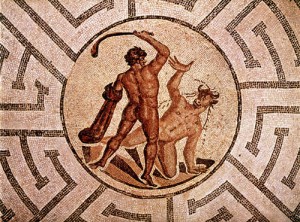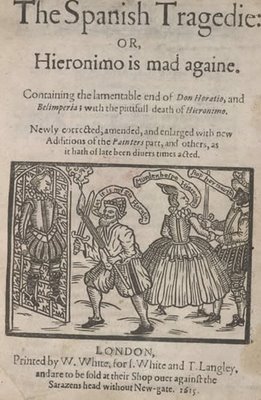“The Subtlest Maze of All”
 Once more, into the labyrinth: When was The Tempest written? Whether you ask this question from an Oxfordian, Stratfordian, Jonsonian or non-aligned Shakespearean perspective, there is only one absolutely certain answer:
Once more, into the labyrinth: When was The Tempest written? Whether you ask this question from an Oxfordian, Stratfordian, Jonsonian or non-aligned Shakespearean perspective, there is only one absolutely certain answer:
The Tempest was written sometime before its first publication in 1623.
Though scholars seldom linger long on this unsatisfactory terminus ante quem, the plain truth is that whatever play King James and his court enjoyed on Nov. 1, 1611, IT MAY NOT HAVE BEEN THE SAME, in all respects, as The Tempest that took pride of place twelve years later in the First Folio. With no prior text for comparison, we can’t rule out the possibility of authorial revision, additions by unattributed “co-authors”, editorial intrusions by Ralph Crane or Ben Jonson, or in-house modifications by the players themselves, however uncomfortable these unknown variables leave us. Therefore, the “rhetoric and logic of academic discourse” (Roger Stritmatter’s phrase) we adopt for examining any aspect of the play contingent upon this elusive date should reflect this basic limitation on our knowledge.
My theory – that Ben Jonson was primarily responsible for The Tempest of 1623 – posits an intentional correspondence between The Alchemist (published 1612) and its near-perfect inversion, The Tempest, (documented as performed twice at court, in 1611 and 1613). With this premise in mind, it is probably no coincidence that Jonson himself provides an earlier terminus ante quem for The Tempest when he embeds the date of the initial performance of Bartholomew Fair within the text of his play. On “the one and thirtieth day of October, 1614″, he tells us, – the day before Hallowmas, that is – he offered the public a rambunctious farce, one in which he seems to cast aspersions on The Tempest that had been performed for the Hallowmas festivities of 1611:
If there be never a servant monster i’ the Fair, who can help it, he says, nor a nest of antics? He is loath to make nature afraid in his plays, like those that beget tales, tempests, and suchlike drolleries, to mix his head with other men’s heels; let the concupiscence of jigs and dances reign as strong as it will amongst you.
 If the documents of court performances in 1611 and 1613 had not survived, Jonson’s sly but unmistakable allusions to Caliban and Trinculo under the gabardine would have been the strongest indication available to scholars that The Tempest must have been written before 1614 – except for one pesky detail. This play, too, was not published until much later, in 1631.
If the documents of court performances in 1611 and 1613 had not survived, Jonson’s sly but unmistakable allusions to Caliban and Trinculo under the gabardine would have been the strongest indication available to scholars that The Tempest must have been written before 1614 – except for one pesky detail. This play, too, was not published until much later, in 1631.
Yes, we do have a record of Bartholomew Fair played at court on Hallowmas, the following day, confirming Jonson’s internal date. However, we have no text or manuscript dated 1614 to prove that Jonson’s embedded references to servant monsters and tempests were in the play performed on that day. When we accept this covert allusion as evidence in dating The Tempest, we do so on faith. Jonson’s complete overhaul of Every Man in His Humour for publication in his 1616 Collected Works should keep us alert to the chance that he may have inserted something new into the text, convenient to his own purposes.
On the other hand, if we can be certain that no one has monkeyed with the 1612 publication date for The Alchemist (as Thomas Pavier did with his false dating of Shakespearean quartos in 1619), I believe that this play will eventually yield the surest terminus ante quem, or date before which The Tempest must have been written. David Lucking has already begun the work, with the intriguing correspondences between the two plays that he revealed in 2004 (“Carrying Tempest in his Hand and Voice: The Figure of the Magician in Jonson and Shakespeare“). When his project is carried forward to cover every act in both plays, those who play The Tempest’s Dating Game may begin to shift their focus away from Strachey’s letter and onto Jonson’s securely-dated Alchemist.
Now for the other side of the question: What is the earliest possible date that anyone could have written The Tempest? Here, the terminus post quem theories become infinitely more subjective and nebulous. However, the paper I delivered at the Shakespeare Symposium in Watertown (“Caliban’s Dream and Shakespeare’s Purge”, May 2010) offered strong evidence that the author of The Tempest drew on the play Satiromastix, published in 1602. Solely on the basis of Caliban and Prospero’s debt to Captain Tucca (a character who appears in Jonson’s Poetaster and reappears in Satiromastix), I am certain that The Tempest must have been written after these two plays of 1601, which were furiously rushed into print by 1602.
 Richard Malim’s theory that the mysterious Tragedy of the Spanish Maze, played at court on Shrove Monday, (February 11, 1605) was really The Tempest is truly tempting, especially from my point of view. Five months after Edward Oxenford’s lonely death on June 24, 1604 – a death for which not one recorded soul shed a tear or wrote an open, sincere epitaph – the court of King James began its Christmas Revels season with a Hallowmas production of Othello, followed by six additional plays attributed to “Shaxberd”.
Richard Malim’s theory that the mysterious Tragedy of the Spanish Maze, played at court on Shrove Monday, (February 11, 1605) was really The Tempest is truly tempting, especially from my point of view. Five months after Edward Oxenford’s lonely death on June 24, 1604 – a death for which not one recorded soul shed a tear or wrote an open, sincere epitaph – the court of King James began its Christmas Revels season with a Hallowmas production of Othello, followed by six additional plays attributed to “Shaxberd”.
Curiously, the only other playwright included in this Shax-fest was Ben Jonson, whose two famous comedies, first Every Man Out of His Humour and then Every Man In His Humour, served as bridges between performances of Henry V , Love’s Labour’s Lost and The Merchant of Venice. As Malim wisely observes:
Why [Every Man Out of His Humour] was chosen baffles the orthodox professor Peter Thomson, but its clear caricatures of both Shakespeare and Oxford, and the demonstration of the relationship between them, readily explain why the choice was made: to keep the record straight.
Just imagine! A third, new play, written by Benjamin Jonson specifically for this Shrovetide occasion honoring his beloved “Shakespeare”, the master-poet who gave him that humiliating “purge”. Here’s his auspicious chance to have Lean Macilente (who’d just appeared onstage in Every Man Out of His Humour) bid a Lenten farewell to the Lord of Misrule embodied by dark, dishonest Iago and merry Sir John Falstaff – ah, heart be still! I confess, this theory sounds terribly, seductively reasonable to me.
Even the title fits Jonson all too well, making it almost impossible to resist. Poor Ben, the apprentice Bricklayer, had been publicly scorned in Satiromastix for his rugged acting in The Spanish Tragedy. And his Masque of Pleasure Reconciled to Virtue shows what a strong hold the figure of the labyrinth had on his poetic imagination. “The Subtlest Maze of All”, a phrase from this masque, is the subtitle of Robert Wiltenburg’s Ben Jonson and Self-Love (1990). Yes, indeed, there’s solid ore to mine in this vein.
And yet…and yet…alas! I’m afraid I have to agree with R. Chris Hassel, who faced a similar temptation when imagining the possible relevance of the “lost play” A historie of the crueltie of a stepmother (1578) to his excellent thesis:
However interesting these early parallels might seem, they are finally, of course, inconclusive without an actual play.
~Marie Merkel

Recent Comments